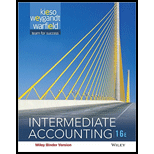
Introduction: Inventory includes raw materials, work-in-process goods and finished products which are held with the purpose of sale.
Case 1: T J International
Given: TJ International is a manufacturer of specialty building products. T J International’s adapted income statement and information concerning inventories from its annual report is provided in the question statement.
(a)
To determine how much would income before taxes have been if FIFO costing had been used to value all inventories.
(b)
To explain: To explain the income tax rate is 46.6%, what would income tax have been if FIFO costing had been used to value all inventories. In your opinion, is this difference in net income between the two methods material. Explain.
(c)
To explain: To explain the use of a different costing system for different types of inventory mean that there is a different physical flow of goods among the different types of inventory.
Case 2: N Pharmaceuticals, Inc.
Given: Description of N Pharmaceuticals has been provided in the question.
(a)
To explain: To explain what would you expect from the physical flow of goods for a pharmaceutical manufacturer to be like.
(b)
To state: To state the factors to be considered while selecting the inventory system.
(c)
To determine the reason for not including the amount of inventory used in stock of inventory.
Case 3: The K Company
Given: Data for K Company reported in its annual report, has been provided in the question.
(a)
To compute: To compute K’s inventory turnovers using:
(1) Cost of sales and LIFO inventory.
(2) Cost of sales and FIFO inventory.
(b)
To compute: To calculate turnover, using:
(1) Sales and LIFO inventory.
(2) Sales and FIFO inventory.
(c)
To state: To state which method you would choose to evaluate K’s performance. Justify your choice.
Learn your wayIncludes step-by-step video

Chapter 8 Solutions
Bundle: Intermediate Accounting 16e Binder Ready Version + WileyPLUS Access Code
- ABC Manufacturing has the following cost data: Direct Labor: $220,000 • Direct Materials Used: $175,000 • Total Manufacturing Overhead: $215,000 Beginning Work in Process: $30,000 Compute Total Manufacturing Costs and Total Cost of Work in Process.arrow_forwardWhat is the contribution margin per unit and the contribution margin ratio of this financial accounting question?arrow_forwardFind the break even point. Accountingarrow_forward
- XYZ Corp. had total sales of $1,200 million for fiscal year 2022. The company's gross profit ratio for that year was 40%. Calculate: Gross Profit Cost of Goods Sold (COGS)arrow_forwardMontclair Textiles uses the weighted average method for inventory costs and had the following information available for the year: • Beginning Work in Process (45% complete, $4,100) = 500 units Ending Inventory of Work in Process (80% complete) = 570 units Total units started during the year = 5,600 units What is the number of units transferred to finished goods during the year?arrow_forwardHorizon Inc. had the following transactions during the month of July 2020: Cash received from a bank loan was $50,000. Dividends of $15,000 were paid to stockholders in cash. Revenues earned and received in cash amounted to $120,000. Expenses incurred and paid were $85,000. What amount of net income will be reported on the income statement for July? A) $120,000 B) $85,000 C) $35,000 D) $15,000arrow_forward
- Please answer the following requirements on these accounting questionarrow_forwardfinancial accounting questionarrow_forwardLambert Manufacturing uses a predetermined overhead rate of $20.50 per direct labor hour. This predetermined rate was based on a cost formula that estimates $252,500 of total manufacturing overhead for an estimated activity level of 12,300 direct labor hours. The company incurred actual total manufacturing overhead costs of $246,000 and 11,700 total direct labor hours during the period. Determine the amount of underapplied or overapplied manufacturing overhead for the period.arrow_forward
- General accountingarrow_forwardYour firm has net income of $420 on total sales of $1,600. Costs are $900, and depreciation is $150. The tax rate is 28%. The firm does not have interest expenses. What is the operating cash flow (OCF)? A) $570 B) $560 C) $420 D) $600arrow_forwardAt the end of the year, Tech Solutions Inc. reported total assets of $200,000 and total liabilities of $85,000. What is the total equity for Tech Solutions Inc. at year-end? A) $285,000 B) $115,000 C) $85,000 D) $200,000arrow_forward

 AccountingAccountingISBN:9781337272094Author:WARREN, Carl S., Reeve, James M., Duchac, Jonathan E.Publisher:Cengage Learning,
AccountingAccountingISBN:9781337272094Author:WARREN, Carl S., Reeve, James M., Duchac, Jonathan E.Publisher:Cengage Learning, Accounting Information SystemsAccountingISBN:9781337619202Author:Hall, James A.Publisher:Cengage Learning,
Accounting Information SystemsAccountingISBN:9781337619202Author:Hall, James A.Publisher:Cengage Learning, Horngren's Cost Accounting: A Managerial Emphasis...AccountingISBN:9780134475585Author:Srikant M. Datar, Madhav V. RajanPublisher:PEARSON
Horngren's Cost Accounting: A Managerial Emphasis...AccountingISBN:9780134475585Author:Srikant M. Datar, Madhav V. RajanPublisher:PEARSON Intermediate AccountingAccountingISBN:9781259722660Author:J. David Spiceland, Mark W. Nelson, Wayne M ThomasPublisher:McGraw-Hill Education
Intermediate AccountingAccountingISBN:9781259722660Author:J. David Spiceland, Mark W. Nelson, Wayne M ThomasPublisher:McGraw-Hill Education Financial and Managerial AccountingAccountingISBN:9781259726705Author:John J Wild, Ken W. Shaw, Barbara Chiappetta Fundamental Accounting PrinciplesPublisher:McGraw-Hill Education
Financial and Managerial AccountingAccountingISBN:9781259726705Author:John J Wild, Ken W. Shaw, Barbara Chiappetta Fundamental Accounting PrinciplesPublisher:McGraw-Hill Education





